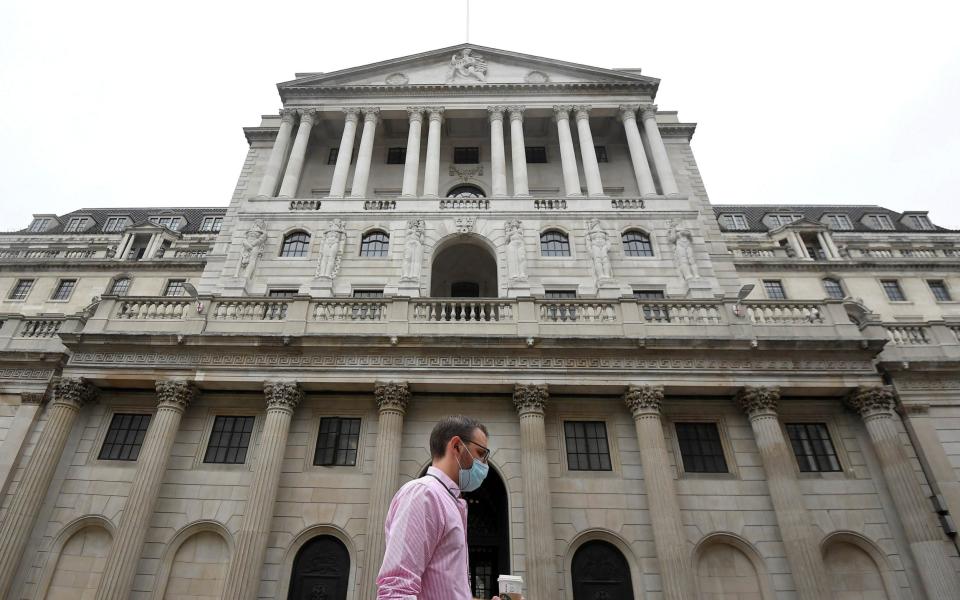Bank of England moves a step closer to negative rates

The Bank of England took another step towards controversial negative rates on Thursday amid rising Covid infections and a looming unemployment crisis.
The Bank’s Monetary Policy Committee (MPC) unanimously voted to hold interest rates at their record low of 0.1pc and kept the scale of its money printing programme unchanged at £745bn.
However, minutes of the meeting said the MPC had been briefed on the Bank's plans “to explore how a negative Bank Rate could be implemented effectively, should the outlook for inflation and output warrant it at some point”.
The Bank of England and the Prudential Regulation Authority “will begin structured engagement on the operational considerations” of the move in the final quarter, the minutes said.
Major central banks including the Bank of Japan, the Swiss National Bank and the European Central Bank have already taken rates below zero, although retail depositors have been shielded.
The Bank has been reviewing its ammunition to tackle the coronavirus crisis since the summer. Governor Andrew Bailey said last month that negative rates were in the "policy tool box" if needed, although the Bank did not expect to use them.
The Bank has also expressed concerns over the potential counterproductive impact on credit provision if lenders' profits were damaged.
The more advanced preparations for a potential move below zero sent the pound lower in the aftermath of the policy decision before regaining ground.
Financial markets - already pricing a move into negative territory by the MPC as economic prospects darken - are forecasting a cut to minus 0.1pc by mid-2021.
JP Morgan economist Allan Monks said: "The BoE is serious about negative rates. The more it talks about this option the more it looks as if it has all but made up its mind."
Despite a slightly faster recovery from April’s nadir than the Bank expected, the UK economy is still 11.7pc below pre-Covid levels and Threadneedle Street is warily eyeing a rising infection rate.
The Bank said: “The recent increases in Covid-19 cases in some parts of the world, including the United Kingdom, have the potential to weigh further on economic activity, albeit probably on a lesser scale than seen earlier in the year ... There remains a risk of a more persistent period of elevated unemployment than in the central projection.”
Threadneedle Street has forecast unemployment peaking at 7.5pc in the wake of the crisis, which would mean a rise of more than 1m in the jobless total.
Figures showed the first signs of a rise in joblessness this week, while redundancies have seen their biggest surge since the financial crisis. More than 2.7m people are claiming Universal Credit.
The winding up of the Government's coronavirus job retention scheme at the end of October also threatens the labour market, with an estimated 10pc of the workforce still on furlough, according to the Office for National Statistics.
“Considerable uncertainty remains around the labour market after the government job support schemes unwind,” the Bank added.
Policymakers could also have to deal with a cliff-edge transition to no-deal trading with the European Union if fractious talks collapse later in the autumn.
Robert Wood, UK economist at Bank of America Merrill Lynch, said there were major risks that the Bank would cut rates in November.
"Any reintroduction of lockdown measures could require more forceful action," he said. "The BoE may need to condition those forecasts on a no deal Brexit if the UK government changes its stance from seeking a deal to accepting no deal, for instance, after the 15 October EU Council meeting. In a no deal Brexit scenario we expect Bank Rate cut to minus 0.5pc in 2021."
However, George Buckley, chief economist at Nomura, questioned whether moderate cuts into negative territory would be effective: "Is a 20 basis point cut realistically going to address the scale of the crisis that we are seeing?"
Minutes from the MPC meeting stressed rate-setters would “keep under review” further tools to help the economy.
The MPC also stuck to its forward guidance in stressing that it would not tighten policy “until there was clear evidence that significant progress was being made in eliminating spare capacity and achieving the 2pc inflation target sustainably”.

 Yahoo Finance
Yahoo Finance 